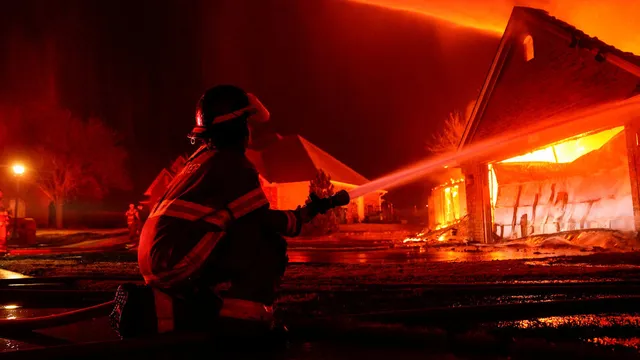
Tragic loss as wildfires claim lives in Oklahoma
2025-03-16 22:32- Wildfires in Oklahoma on March 14 resulted in at least three fatalities and severe destruction across multiple counties.
- Over 300 structures were lost and many residents were forced to evacuate due to the extreme fire weather conditions.
- Authorities warn of continued elevated fire risks as weather conditions are expected to worsen in the coming days.
Express your sentiment!
Insights
In Oklahoma, wildfires erupted amid extreme weather conditions on March 14, 2025, leading to significant destruction and loss of life. The wildfires were fueled by extremely dry conditions, high winds, and humidity levels that plunged to record lows. As of that day, more than 130 active wildfires had been reported across the state, resulting in over 300 buildings destroyed or damaged. Officials declared a state of emergency as residents were forced to evacuate and assess the damages to their homes and properties, with impacts being felt in areas like Stillwater, which saw at least 50 homes destroyed. The catastrophic situation was intensified by a powerful storm system that swept through the central United States, contributing to the high winds of up to 83 mph and sparking multiple tornado threats across the region. In addition to the wildfires, the storm system was linked to a series of car accidents caused by poor visibility from dust storms, which resulted in fatalities. The National Weather Service had issued warnings about the dangerously low humidity levels and dry conditions that set the stage for these wildfires. Oklahoma Governor Kevin Stitt experienced personal losses from the fires, including a farmhouse that was destroyed. In a public statement, he expressed his sympathy for all affected and emphasized the need for support and rebuilding efforts in the aftermath of the wildfires. Emergency responders worked tirelessly to contain the fires, but the scorching conditions posed ongoing risks. Looking ahead, meteorologists anticipate a continuation of the dry and windy conditions that could exacerbate the wildfire risks, urging residents to remain vigilant. The devastating wildfires in Oklahoma serve as a stark reminder of the dangers posed by extreme weather conditions and the potential for rapid devastation that can follow when such conditions coincide.
Contexts
Extreme fire weather conditions in the Plains region have become an increasing concern in 2025, driven by a combination of climatic factors and environmental changes. The incidence of prolonged drought periods, coupled with rising temperatures, has created an ideal environment for wildfires. Research indicates that the last several years have seen a significant rise in both the frequency and intensity of extreme fire weather events. Analysts have noted that the Plains, characterized by its vast grasslands, is particularly vulnerable due to the limited moisture and availability of dry fuel sources that are capable of igniting effortlessly in these conditions. This not only poses immediate threats to life and property but also impacts ecological systems and air quality across wider areas. The ongoing impacts of climate change further exacerbate these fire threats, underscoring the need for prepared and coordinated responses to protect communities at risk in the Plains region. Fire management agencies are already observing an uptick in wildfires occurring earlier in the year than historically recorded, a trend that correlates strongly with advanced climate models predicting warmer spring and summer months. Efforts for mitigation are underway, focusing on improved land management practices, early warning systems, and effective community engagement strategies. Agencies are calling for increased investment in fire prevention and preparedness measures, such as controlled burns and the establishment of firebreaks, especially during peak fire risk seasons. These proactive approaches are crucial for enhancing resilience to the heightened fire risks faced in the Plains. Additionally, the socioeconomic implications of extreme fire weather conditions cannot be overstated. Communities reliant on agriculture are facing existential threats as crop yields become uncertain in the wake of severe droughts followed by potential wildfire outbreaks. Local economies suffer as resources are diverted to firefighting and recovery efforts while individuals face loss of homes, livestock, and livelihoods. Public health remains a significant concern as smoke from wildfires infiltrates air quality, leading to respiratory problems among vulnerable populations. Thus, tackling these challenges is twofold—addressing immediate fire risks while also preparing to support affected communities and rebuild livelihoods in the aftermath of such events. Looking ahead, collaborative efforts among government, non-profit organizations, and community stakeholders are essential for mitigating the impacts of extreme fire weather conditions in the Plains. Enhancing cooperative frameworks for resource sharing, implementing educational programs on fire safety, and incorporating indigenous knowledge on land management practices will be pivotal in building a comprehensive strategy to address this crucial issue. As data continues to emerge and our understanding of fire behavior evolves, maintaining flexibility in planning and response strategies will be key in adapting to the ever-changing landscape of fire risks in the region.